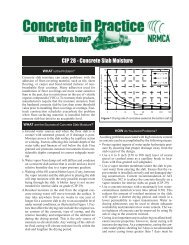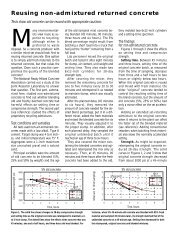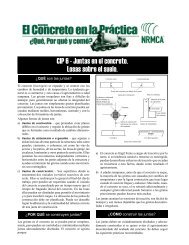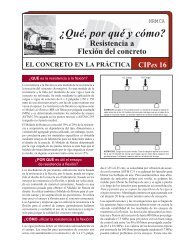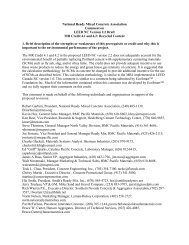Fall 2004 - National Ready Mixed Concrete Association
Fall 2004 - National Ready Mixed Concrete Association
Fall 2004 - National Ready Mixed Concrete Association
You also want an ePaper? Increase the reach of your titles
YUMPU automatically turns print PDFs into web optimized ePapers that Google loves.
ufacturers are responsible for approximately<br />
75 percent of U.S. production (See Table 1).<br />
Table 1 - TOP TEN U.S.<br />
CEMENT PRODUCERS<br />
Lafarge North America<br />
Texas Industries<br />
Holcim (U.S.)<br />
Essroc Italcementi Group<br />
Cemex USA<br />
Lehigh Cement<br />
Buzzi Unicem USA<br />
California Portland Cement<br />
Centex<br />
Ash Grove Cement<br />
Cement is an effectively consolidated<br />
market. This is not to suggest that the list of<br />
companies found in Table 1 will remain<br />
unchanged, but rather to suggest that the<br />
relatively high degree of concentration of<br />
production means the marketplace will generally<br />
exhibit the behaviors of a consolidated<br />
industry.<br />
The next historic link in the vertical integration<br />
chain occurred in the aggregates<br />
industry. Beginning in the 1980s, several<br />
strategic purchasers emerged and either<br />
began or greatly enhanced their acquisition<br />
activities in the sector. The exact level of<br />
consolidation of the aggregates industry is<br />
uncertain and varies significantly from market<br />
to market. However, one barometer of<br />
consolidation is that on a national basis, the<br />
top 20 producers out of 5,000 total producers<br />
control approximately 35 percent of production<br />
at present. Furthermore, as shown<br />
in Table 2, the top four producers control<br />
approximately 25 percent of total production.<br />
Based on these statistics, we believe<br />
that additional consolidation will occur in<br />
the aggregates industry.<br />
Table 2 – TOP FOUR U.S.<br />
AGGREGATE PRODUCERS<br />
Vulcan<br />
Martin Marietta<br />
Hanson<br />
Oldcastle<br />
The next logical extensions in the vertical<br />
integration chain downstream from aggregate<br />
operations are hot mixed asphalt and<br />
ready mixed concrete companies. In the<br />
early 1990s, several asphalt companies were<br />
purchased. Then in the mid- to late-1990s<br />
ready mixed operations were sought. The<br />
degree of consolidation in asphalt is similar<br />
to aggregates in that the top 20 companies<br />
presently control approximately 35 percent<br />
of the market. In the ready mix industry, the<br />
present level of consolidation is measured by<br />
the top eight producers controlling approximately<br />
20 percent of the total yards sold in<br />
the United States.<br />
Of course, there have been variations of<br />
theme in the marketplace in that there still<br />
exist “pure” cement producers, “pure” aggregate<br />
producers and “pure” ready mixed concrete<br />
operations. As a general trend, though,<br />
it is difficult to argue that the strategy of vertical<br />
integration has been, and still is, a driving<br />
force in ready mixed concrete<br />
consolidation.<br />
Another force in the consolidation of the<br />
ready mixed industry is the capital markets.<br />
Once consolidation begins in a business sector,<br />
outside capital is usually drawn toward<br />
that sector. This phenomenon was especially<br />
pronounced during the late 1990s when not<br />
only were international publicly-held companies<br />
attracted to invest in ready mix (aka,<br />
strategic buyers), but we also witnessed the<br />
more direct outside capital investment of<br />
organizations who sought to create “roll-ups”<br />
(aka, financial buyers).<br />
With the general decline in the capital<br />
markets from 2001 to 2003, the appetite for<br />
investing in consolidation activities also<br />
declined. This decline impacted the financial<br />
buyers more than it did the strategic buyers.<br />
Access to capital is critical to the financial<br />
buyer, whereas, the strategic buyer was still<br />
opportunistic to acquisitions that would further<br />
extend their vertical integration strategies<br />
in existing markets or in new<br />
geographies.<br />
In summary, the answer to “why is consolidation<br />
occurring in the ready mix industry”<br />
is two-fold. First, a predominant<br />
business strategy of vertical integration is<br />
being pursued. Second, outside capital has<br />
been attracted to the sector. Is there any<br />
chance that both of these factors will vanish<br />
and consolidation will stop occurring The<br />
answer is maybe. The strategy of vertical<br />
integration has been deemed a “failure” in<br />
some industry segments and has been<br />
undone. This is what drove the significant<br />
divestitures, spin-offs and shut downs from<br />
major U.S. companies beginning in the mid-<br />
1980s. It is conceivable that firms could<br />
determine in the future that being a good<br />
cement producer or a good aggregates producer<br />
does not automatically mean that they<br />
will be a good ready mixed concrete producer<br />
as well. As for the inflow of capital, that<br />
will continue as long as sufficient opportunities<br />
for adequate returns are present. But,<br />
given the recent drop in ready mixed profit<br />
margins, this could “dry up” the capital<br />
inflow into the industry.<br />
Even so, if both of these factors were to<br />
come about, it does not mean that the<br />
industry will “de-consolidate” and go back<br />
to what it looked like in the 1970s. Business<br />
factors such as environmental laws, employee<br />
issues and general business conditions are<br />
not the same as they were 30 years ago. Furthermore,<br />
some level of consolidation always<br />
occurs as profitable companies generally<br />
invest in the same industry as long as opportunities<br />
are available.<br />
What Happens in a<br />
Consolidating Marketplace<br />
We explored why consolidation is occurring.<br />
Let us take a look at the implications of<br />
this activity. In a consolidating marketplace,<br />
the following activities are typically<br />
observed:<br />
• Mergers and acquisitions<br />
• Difficulty generating significant<br />
“organic” growth (i.e. – it is easier to<br />
buy it than to build it)<br />
• “Rationalization” of market positions of<br />
larger players by either service offerings<br />
and/or geographies<br />
• Capital investment to drive down costs<br />
and increase productivity – strong<br />
motivation to become the low-cost producer<br />
• Barriers to entry of new participants<br />
rise<br />
Each of these elements is present to some<br />
degree in the ready mixed industry. Let us<br />
examine each element in more detail.<br />
Mergers and Acquisitions and Difficulty<br />
Achieving Organic Growth: The first two<br />
characteristics are reviewed together because<br />
they are quite naturally tied together. If it is<br />
easier for a firm to buy than to build, the<br />
natural outcome will be increased acquisition<br />
activity. Further pushing this is the<br />
availability of motivated sellers. The ownership<br />
of privately held companies in the United<br />
States is experiencing a dramatic<br />
transformation that will continue throughout<br />
the next 10 years, primarily due to a<br />
demographic “bubble,” which is just now<br />
beginning to pass through our society. For<br />
the vast majority of privately held companies,<br />
they are almost to the end of either<br />
CONCRETE in focus ı 41



